 Rome demands a review! Today we look at the card game Glory to Rome. Rome has been decimated by a fire and it’s up to you to help rebuild it. Each player will take on the role of a Patrician hoping to gain influence and fortune during the rebuilding. With some unique mechanics and mutli-use cards, Glory to Rome is sure to keep you on your toes. Yet is Glory to Rome worth the time it takes to play or does it feel like it was built in a day? Read on to find out!
Rome demands a review! Today we look at the card game Glory to Rome. Rome has been decimated by a fire and it’s up to you to help rebuild it. Each player will take on the role of a Patrician hoping to gain influence and fortune during the rebuilding. With some unique mechanics and mutli-use cards, Glory to Rome is sure to keep you on your toes. Yet is Glory to Rome worth the time it takes to play or does it feel like it was built in a day? Read on to find out!
Glory to Rome is a card drafting and hand management game for 2-5 players. The game plays in about 45-60 minutes and is best played with any number of players.
Game Overview:
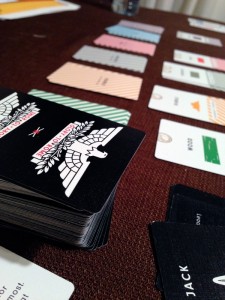
In Glory to Rome each player must utilize the cards in his hand in one of 4 different ways. Each card can represent a client, a resource, a building or just victory points. During the game, players will be using each of these four parts of the cards to construct their part of the city and to try and collect the most influence. Each turn, a player will choose one of the 6 different roles to play to further their goals. As the lead player choose a role, the rest of the player may also follow suit, even when it’s not their turn. This makes for a very fast moving and interactive game. At the end of the game, the player with the most influence will be the winner.
Components:
Note: For this review, I’ll be talking about the Black Box edition of Glory to Rome.
As of right now it’s somewhat of a crap shoot as to which version of Glory to Rome you can find. The game has been in and out of print since 2005 in a few different editions. I’m not going to get into the issues of the ill-fated kickstarter campaign, but no matter which version of the game you find, the game will play the same.
The game comes with a deck of 159 order cards each of which is split into 3 different parts. On the left side of the card is the client, a role the player can use. The bottom if the card contains influence and building material. The center of the card is the actual structure that can be built with its associated power. The game also comes with a few other cards: Merchant bonus, foundations and jacks. In addition to the cards, the game also comes with a double sided player mat and central board.
There is some debate as to which edition of Glory to Rome is the best. I’m a big fan of the Black Box edition because I love the stylistic and minimalist artwork on the cards. Others like the cartoony artwork on the I.V. edition. And most everyone loves the artwork in the Polish edition…which is useless if you don’t actually speak polish.
How to Play:
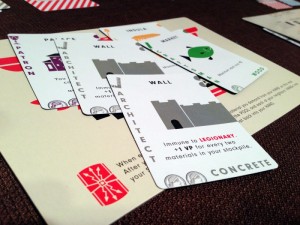
To start the game, create a pile of building sites for each of the 6 foundations. Each pile gets one card per player. After that, each player starts with a hand of 5 order cards and play begins with the starting player.
On a players turn they may:
1. Lead – If a player leads, they choose a role from their hand (the role is on the left side of the order card) and play it on their play mat. After they announce the chosen role, each other player may choose to follow or think. If they follow, they must each play a matching role card (or a wild). If they don’t want to (or can’t) they must think (see below).
2. Think – Thinking means drawing cards. When a player thinks, they draw up to their hand limit (starts at 5) or they may draw a jack (wild card). If they already have 5 cards in their hand, they may draw 1 additional order card instead.
That’s the basic turn structure. The leading player will take their role action and then each of the other players that followed may use the same action (in a clockwise order). Once each player has finished their action, the leader card rotates to the next player, all the cards that were used to lead/follow are put into the pool and the round begins anew with the next player.
The possible actions are:
Patron: Take a card from the pool and add it to your clientele. This is helpful because when you take an action, you can repeat the action for each matching client in your clientele.
Laborer: Take a card from the pool and add it to your stockpile (can be used later for building materials).
Legionary: Take a card from the pool and from each of your neighbors. This is done in a “go fish” fashion by calling out a material (Rome demands concrete!). If your neighbors have one, they have to give one to you.
Craftsman: Start a new building or add a material to it from your hand.
Architect: Start a new building or add a material to it from your stockpile (the cards that the laborer/legionary collected)
Merchant: Move a card from your stockpile to your vault (Victory points!)
The game can end in a few different ways:
• The draw deck runs out
• The last face up foundation card gets used
• A catacomb is built
• A player has built the Forum Romanum and fulfilled its requirements.
When the game ends, it ends immediately. Players count up their victory points and the one with the most is the winner.

Game Experience:
So now that you have a high level overview of how the game is played, we can talk about what it’s like to play. First off, in case you can’t tell already, the game has a bit of a learning curve. I’d say that it will take most players at least a full game to really get comfortable with what they are doing. Between all the different uses for the cards and performing actions when it’s not a player’s turn, there is a lot to take in. Prepare to feel overwhelmed for the first few rounds at least.
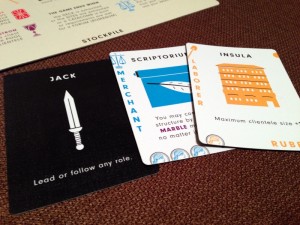
However, once you get a feel for the game, it’s pretty awesome. Glory to Rome is a fantastic card game that allows for a lot of diverse strategies and combos. And combos there will be lots of.
Each building has a special power and some will play off others very well. It’s particularly exciting to construct two buildings and realize that you have just gotten huge advantage. I love how many of the buildings interact different with the game, it can keep you on your toes for sure. Because there are so many different cards, I’m still constantly finding new combinations to try out, even after a lot of plays.
Speaking of interaction, there is a ton of it in Glory to Rome. Since every player will be leading or following on a turn, players have to constantly pay attention to what’s going on. Players will also interact via the roles chosen as the Legionary has you stealing cards from your opponents. Downtime in Glory to Rome is incredibly minimal, especially towards the end of the game when players have a few different clients in their pool.
Interestingly, Glory to Rome also has a very uneven ramp up. The game starts off slow with players doing minimal actions on their turn. However, after some buildings get constructed and players start recruiting clients, the game moves from a slow jog to a 100 yard dash. When Glory to Rome gets moving, it takes off. All of a sudden players are drawing cards, getting 2 or more actions on their turn and finishing buildings. The ramp up is just crazy, but it also keeps the game very interesting.
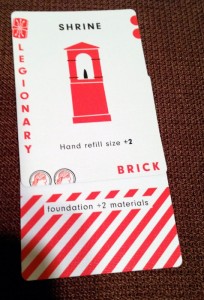
With all the different options available to players, it also means there are a lot of ways to win. There is not one strategy you can perfect and always come out ahead. You need to be flexible in Glory to Rome. Your strategy will change depending on what cards you draw, which cards you can grab from the pool and what actions your fellow players are allowing you to take. I love that about this game. I like games that keep you on your toes and require you to always pay attention.
And pay attention you must. Glory to Rome feature some very tough decisions and you have to make them each and every turn. Because cards can be used in so many different ways, you have to decide how each one will be used when it leaves you hand. Sometimes you have a fantastic building that you want to construct, but you have to use it as a material in another building. Players can agonize over how to best use their cards and sometimes it really hurts to turn that powerful building into a piece of marble. When a card game can throw this at me, I’m always intrigued. In Glory to Rome, you aren’t just along for the ride, you need to pilot the ship at all times.
Even with all these decisions and different ways to use cards, the game still plays incredibly smoothly. Turns will go by at a rapid pace and even though the game can take an hour to play, it never feels that long. There is always something to do in Glory to Rome, even when it’s not your turn.
Glory to Rome also scales very well. I’ve played the game from 2 players up to 5 players and had fun with every player count. The game definitely plays different at 2 then it does at 5, but both counts are very enjoyable. I never once had a game end by drawing the last order card when playing with 2 players, however our first 5 player turn ended that way. It was very unexpected! That’s also why I couldn’t recommend a best player count. I think it plays great at any number.
Final Thoughts
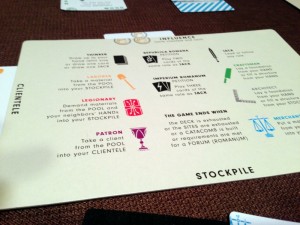
Other than the steep learning curve, I really have a hard time thinking of things I don’t like about Glory to Rome. The game plays in a good amount of time, the interaction is very high and so is the decision making. To be able to get all of this in a card game is just fantastic. Many card games are expected to be nothing more than a filler game, but Glory to Rome is easily more than that. There is an incredible amount of strategy a player can draw upon to win this game. Glory to Rome should keep you entertained and occupied for many plays.
If Glory to Rome sounds interesting to you then I’d urge you to give it at least a couple of plays. Your first game will be confusing, slow and probably a little awkward. But eventually, it will all click and you will realize how much potential for fun there is in this game. So if you are looking for a card game that scales well, has a whole lot of replay value and some interesting mechanics, then you’ve got a great option in Glory to Rome. Give this one a try today, you won’t regret it. Just don’t forget to stockpile the marble.
If you are interested in getting a copy for yourself, it’s about $30
Final Score: 4 Stars – A fantastic card game with some deep strategy and great player interaction. You just have to get past a bit of a learning curve.
 Hits:
Hits:
• Heavy player interaction
• Deep strategy that can change each game
• Involved game play will keep your attention for the whole game
• Very minimal downtime
• Scales great from 2-5
Misses:
• A heavy learning curve for a card game
• Artwork on the different editions vary greatly.





















